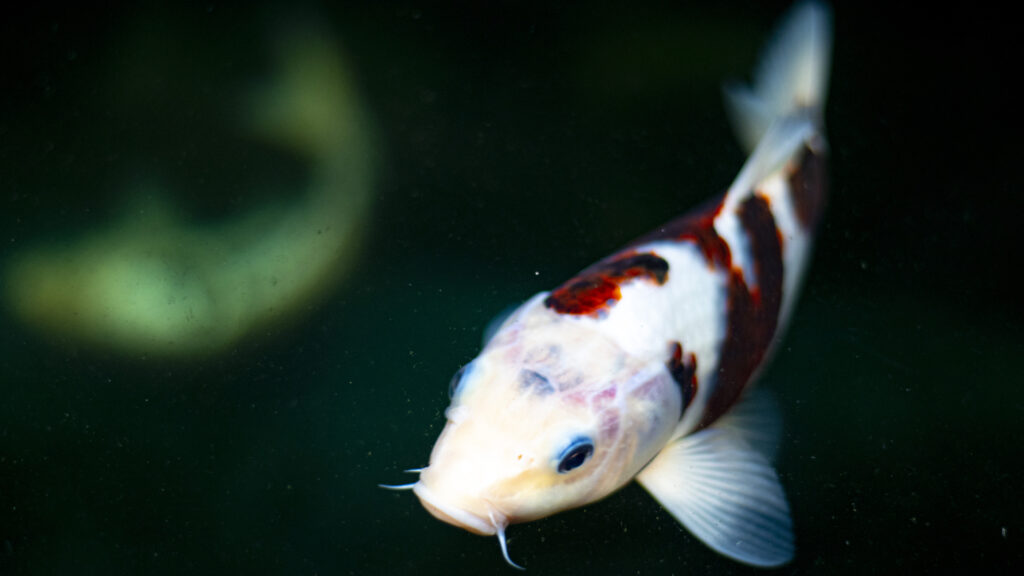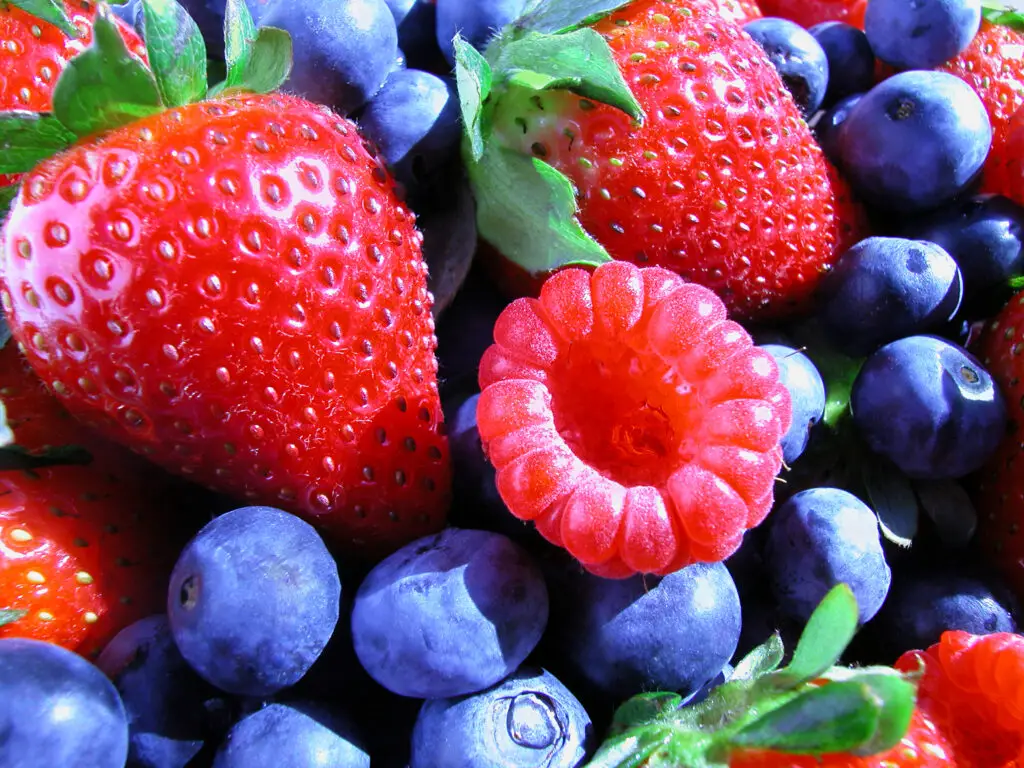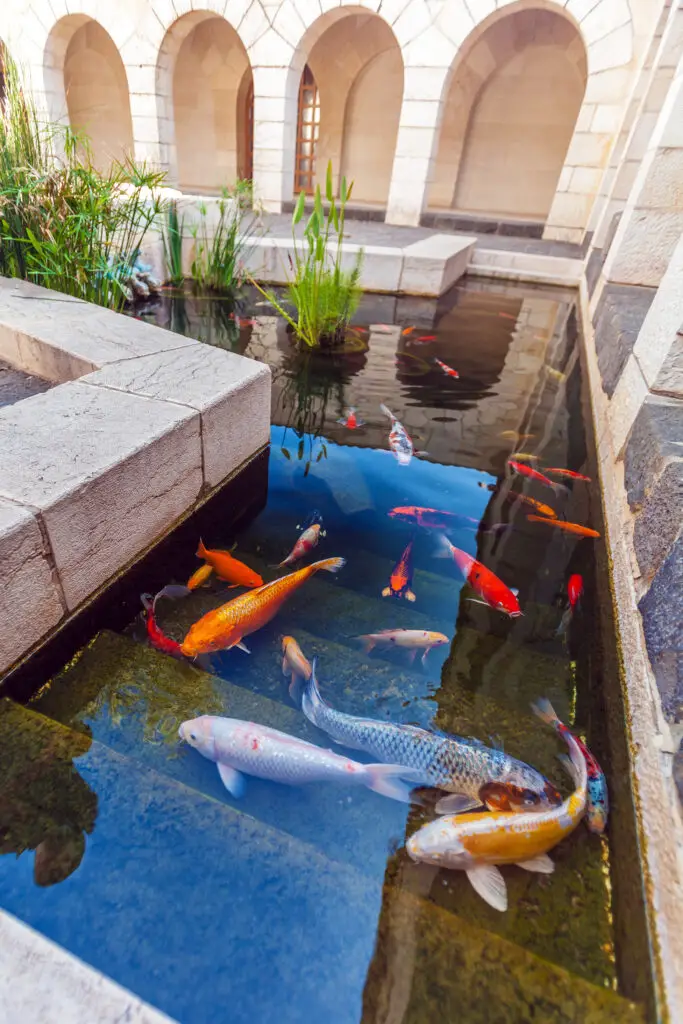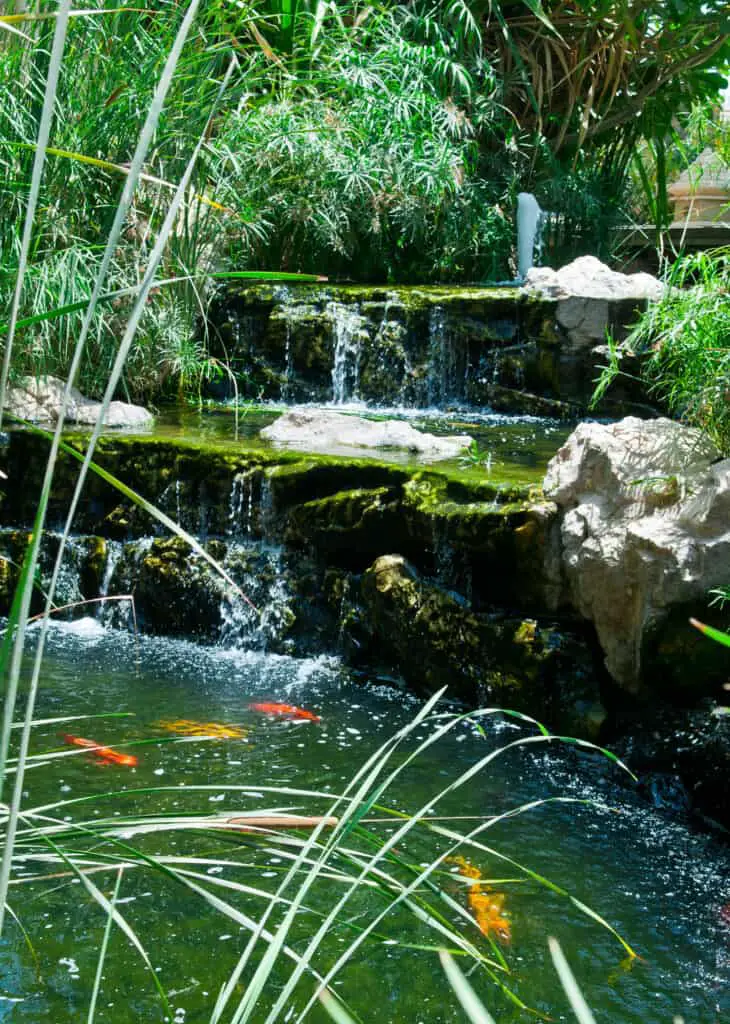
The Goromo Koi is a relatively new breed of Koi and is the result of breeding a Kohaku and Asagi Koi in the 1950s. Goromo Koi are very popular due to their characteristics, and people often enter them into shows for judging.
There are different varieties of Goromo or Koromo Koi. The Ai Goromo is the most favorable. Generally, Goromo Koi have red patches on their bodies and blue coloration within their red scales. These Koi can also get very expensive due to their unique coloring and difficulty breeding.
Caring for a Goromo Koi is pretty straightforward, but it can also be expensive. For this Koi to thrive, you need to ensure that its environment is suitable. Let us look at everything you need to know about this Koi.
Pro Tip: If you’re tired of wasting money and making costly mistakes on the koi-keeping hobby or are thinking about buying koi fish but don’t know where to start, I strongly suggest you check out this ebook. I recently read this ebook, and it contains SO much useful information, such as:
- 3 proven steps to identify koi fish diseases
- WARNING: 3 things you should NEVER do when it comes to caring for koi
- When to seek professional help when it comes to looking after your koi
The Meaning Of “Goromo”
People use the terms Goromo and Koromo interchangeably. The word Koromo means “clothed” or “robed” in Japanese. This term references Goromo Koi’s blue-tinted Hi markings.
What Color Are Goromo Koi?
Goromo Koi have red patches on their bodies, with a blue-tinged coloration within their red scales. These Koi are very elegant and refined in appearance. They look pretty similar to a Kohaku Koi. There are different types of Goromo Koi, namely:
The Ai Goromo.
Of all the Goromo varieties, the Ai Goromo is the most favorable. The term “Ai” translates to “blue” or “indigo .” This Koi is white with a hi pattern similar to the Kohaku, except the Ai Goromo’s red scales are edged in dark blue or black, reminding you of their Asagi ancestry. The dark lining of their scales is not that visible when they are young and takes years to be fully visible.
Ai should not be present on the head of Ai Goromo. Their dark blue or black color should not intrude into the white areas. If these colors invade, it is no longer an Ai Goromo but a Goshiki.
The Budu Goromo.
“Budu” translates to “grape.” This sub-variety koi shares similar qualities to the Ai Goromo. The most significant difference is the scalage of the Hi pattern. The Budu Goromo’s red scales are overlayed with a deep purplish color. They do, however, share the white skin of the Ai Goromo. However, if the dark color intrudes into the white area, the Budu Goromo becomes a Goshiki.
The Goshiki
The term “Goshiki” means “five-colored” in Japanese. This Koi has red, white, dark blue, light blue, and black color tones. It can also have a purplish color tone when the black and blue colors overlap. This type of Koi is highly diverse. They have strong Asagi ancestry.
Traditionally, Goshiki is a dark fish with messy patterns and clear patches of hi here and there on the face and back. With other Goshiki, you can see the cross between the Kohaku and Asagi koi. These Koi have black reticulation that covers the whole body.
You will also find more varieties of this Koi, namely the Gin-Rin Goshiki and Doitsu Goshiki. These beautiful varieties can sometimes appear silver, gold, or blue-gray. These colors appear because the colors of the Koi’s skin underneath influence the reflective scales.
Sumi Goromo
This Koi has its reticulation pattern on the inside of the scales in the hi pattern, but it has a black tint, making it the darkest one of the Goromo varieties. It is also a scarce variety.
The reticulation is scattered and random.
Goromo Showa
This Koi has an Asagi and Showa parent. The result is a pattern not restricted to the Hi but visible on the rest of the body.
Goromo Sanke or Sanshoku
This Koi has blue reticulation, with the addition of some black anywhere on the body or head. Goromo Sanke has one Asagi and one Sanke or Sanshoku parent.
Caring For Goromo Koi

Before getting a Goromo Koi for your pond, you need to know certain things. For example, these fish require healthy diets and perfect water quality that meet their needs. The temperature, pH level, oxygen, and salinity must be perfect to avoid putting stress on your Koi.
Goromo Koi Need A Healthy Diet

To keep a Goromo koi healthy, you must ensure it has a balanced diet. The diet plays a role in developing and maintaining the colors of Goromo Koi. People frequently feed Goromo Koi diets that contain color enhancements, like spirulina or krill. This Koi also needs ample protein for proper growth.
Diet plays a massive role in the color of Goromo Koi. If you want to amplify the blue color of a Goromo, it should be fed food that is supplemented with spirulina, astaxanthin, and guanine.
However, if you don’t wish to show your fish at shows, color enhancers won’t play a huge role in your Koi’s diet. It is up to you if you want to feed your Koi color-enhancing supplements.
Koi are bottom feeders, but floating food can encourage them to come to the surface. They’re omnivores and eat various food, including peas, watermelon, and lettuce. Koi eat very little food in the winter due to the halt of their digestive systems.
Water Quality That Meets The Goromo Koi’s Needs

The water quality of the Goromo Koi must meet their needs. The water temperature must be between 50° F and 78° F. Feeding below this temperature is not recommended.
Water temperature is critical to keep your fish happy and healthy since temperature influences their metabolic process. In warmer water, fish need more food and more oxygen. It is thus critical to their survival.
For your Goromo Koi to flourish, the alkalinity of the water is essential. Alkalinity is expressed as “pH” and has a 0 to 14 scale, with seven being neutral. Each new level is ten times more than the previous one, not one. The pH level for Goromo Koi should be between 7.5 and 8.5. The best way to ensure that your water is within this range is to purchase a test kit.
To maintain the perfect pH level, regular water changes are necessary. If you still find your pH level too low, adding rock work or substrate will naturally raise the water’s pH level.
Goromo Koi requires at least seven parts per million of dissolved oxygen. If it falls below six, your Koi will become stressed and lethargic. So make sure to keep your Koi happy and keep the oxygen at seven parts per million.
You can keep the salinity very low, between .05 and .15 parts per trillion. Also, ensure that there are only 75 to 100 parts per million of total dissolved solids like metals, minerals, salts, and sulfates.
The ponds Koi live in should be at least one and a half meters. The pond should have proper filtration and aeration and must be maintained.
Koi’s Life Expectancy
In Japan, Koi usually live for around 40 years. The average life expectancy for Koi outside of Japan is 15 years. Some Koi have even reportedly lived up to 100 to 200 years.
How Much Does Goromo Koi Cost?
Goromo Koi vary in pricing. Due to their unique coloring and difficulty breeding, they can come with a costly price tag. Many young Koromo can cost between 200 and 500 USD. Others can go up to several thousand dollars due to their size and specific variety, like the rare Sumi Goromo.
The cost also depends on the seller and location. However, it’s vital to buy Goromo Koi from reputable breeders. They will have credentials to prove that they are trustworthy and ethical.
Questionable fish farms also sell Goromo Koi. But these farms usually do not prioritize the well-being of fish. They can also have illnesses. It is important to report these people and avoid supporting them.
Judging Goromo Koi
Many people think they have a champion Koi on their hands. But how can you tell?
Don’t think anyone can judge your Koi. Koi judging started in the late 1960s in Western Japan. Hobbyists would hold shows to select the best Koi among the entrants. There are three organizations that judge Koi shows in the United States: affiliates of the Japanese ZNA, Associated Koi Clubs of America, and the American Koi Judges Association. These judges are certified and have years of experience.
Confirmation
There are different categories on which Koi are judged. Confirmation is usually the most heavily weighted category. This category has to do with the proper appearance of the fish. There should be no irregularities or infections.
The Koi should have the correct number of fins, eyes, etc., and proper symmetry and shape. All Koi are torpedo-shaped, with the biggest part of their bodies at their shoulders.
Color and Pattern
Color is vital when it comes to judging Koi. It’s about depth, vibrancy, and intensity. The color should be thick and healthy and appear all around the body of the Koi.
Judges frequently regard Goromo Koi with distinct “robing” as superior. This implies that many judges seek Ai pigmentation running down the back of Koi like a robe. The pigmentation must be well-defined within or around the margins of the Hi scales.
Though Goromo Koi can have any patterning indicative of Kohaku, Sanke, or Showa, a stepped Hi patterning is most favored. This means that there are many uniform “patches” of Hi down the back of the Koi. In all kinds of Koromo, having Hi on the head is considered a positive trait. Having Ai on the head is regarded as a negative trait.
Many judges favor all-white fins on Goromo, except for a small amount of Hi at the base of their pectoral fins if it helps emphasize the fish. It’s not favorable if the pigmentation is outside the area of the Hi. Ai should only exist within the scale of the Goromo.
Sumi Goromo can have a black patch present on the Hi on their heads. This feature is different from other varieties, which should only have white and red on their heads. Younger Koi’s colors must be lighter since they will only grow darker with age. Therefore, younger Koi with darker Ai or Sumi will be judged unfavorably.
Bigger Koi Are Better
The body should be symmetrical and have no deformities. The larger the Koi, the more favorable it is. If the Koi is large, it indicates that it is fully matured and has reached its potential.
The Koi’s Behavior and Presence
The Koi should be elegant and judged on how it handles itself in an unfamiliar environment. Judges assess its overall appearance and orientation.
Koi are judged on their presence as well. First impressions matter! A champion Koi should make a judge think, “Wow!”. The Koi’s health and vitality should distinguish itself from others.
Koi Spawning Season

Koi, including Goromo Koi, typically start their spawning season during May and June, when it is Spring. The male Koi will start following the most fertile female. When the time arrives to lay eggs, the males will chase the female around and nudge her side with their mouths.
Once she sheds her eggs, they will immediately become fertilized by the male Koi following her. Female Koi lay thousands of eggs, but other Koi eat most of them. This is why most ponds have green filters inside them so that some of the eggs can be collected and moved to an isolated area for hatching.
Conclusion
Goromo Koi are beautiful fish and can be pretty expensive. You need to maintain the fish to ensure they remain healthy and vital. If you want to enter your Goromo Koi into a show for judging, you have to ensure that the fish is free of any irregularities, is healthy, vibrant, and has the correct appearance.
They are also judged on first impressions. Each variety has its characteristics, so you must do your research and get advice from experts before entering your Goromo Koi into a show. To keep your Goromo Koi healthy, change the water regularly and give it a balanced diet and color enhancers if you want. And that’s everything you should know about Goromo Koi!
References
https://www.liveaquaria.com/article/134/?aid=134
https://www.oldest.org/animals/koi-fish/
https://www.nashvillezoo.org/our-blog/posts/its-spawning-season-for-zoos-koi-fish

